What is Plywood?
As its name suggests, this board is made with plies of wood glued together in odd numbers through intense heat, pressure and phenolic resins until it reaches the desired thickness. Each layer is glued after rotating it so that the direction of the grain or the fibers is perpendicular to the ones in the layer above or below, giving it its unique stability and stiffness.
All kinds of wood tend to warp as they absorb or exhale moisture, as I explained in this article, but this method of building plywood by alternating the direction of the grain almost completely bypasses that problem.
To obtain the plies, manufacturers place a log on a kind of giant lathe, and a blade peels it into a sheet as the lathe rotates the log, similar to how a pencil sharpener works.
Plywood can be made from many kinds of timber, sometimes one panel may be made from two different kinds of wood, but the most common types are birch (hard plywood), poplar (soft plywood) and pine wood, of average hardness.
In Europe, poplar plantations for making plywood are a common sight. The choice of birch or poplar plywood is sustainable as long as they comply with the regulations. These species are fast-growing and abundant, and the forests are repopulated as the trees are cut down. In the case of poplar, almost the entire tree is utilized.
Types of Plywood Boards:
Boards are usually 250cm long and 125cm wide, although many different sizes can be found. To give you an idea of how much they weigh, a birch board around 18mm thick with the above measurements weighs approximately 35kg. The same board in poplar weighs around 20. There are many thicknesses, the most used ones being 3, 5, 7, 9, 12, 15, 18, 20 or 30mm.


These are the main types of plywood that you can find in a carpentry store:
1- Hard birch plywood, in this case 18mm thick and BB/BB quality. It’s the most common hard plywood, made entirely from birch. It’s reasonably priced.
2- Soft poplar plywood, with a eucalyptus veneer; this one is 9mm thick. Manufacturers veneer some soft plywood with harder wood to reinforce their outer faces and make painting and varnishing easier. It’s reasonably priced.
3- Soft poplar plywood with okoume veneer, 18mm thick. Reasonably priced.
4- Soft plywood made entirely out of okoume, 18mm thick. It’s increasingly rare to find due to the scarcity of okoume wood. I stopped using it years ago and now I use poplar instead.
5- Birch trailer floor plywood. One of its faces is anti-slip, and the other is smooth. It’s used as flooring in vans, boats and playgrounds. The smooth face is perfect for home-made worktables, where a smooth surface that’s also a little slippery and sturdy is appreciated. It’s quite expensive.
6- Hard birch plywood with melamine on both sides. It’s similar to trailer floor plywood, but it’s meant to be used in decoration and furniture. It’s an amazing kind of board, very stiff and stable.
Because it has a melamine layer, it’s also perfect for home-made tool worktables. Melamine comes in many colors and textures, sometimes imitating the grain of some woods. The only disadvantage is that it can’t be glued to another board on its sides, at least not with wood glue. It’s a very expensive board.
Surely you’ve heard about marine plywood. In actuality, it’s not so much a type of board as a manufacturing method. Almost all of the boards described above can be marine or not. In order to make marine plywood, the proportion of wood and phenolic resin is changed, as well as other parameters, to obtain plywood that is resistant in almost all conditions.
Be careful, because some places will try to sell normal plywood as if it were marine, as the name has spread to all kinds of plywood. It’s only necessary in very adverse conditions, otherwise normal plywood should be enough.
As you can see in the picture, veneered plywood is like any other plywood, but it has 0.5mm layer of another wood glued to it on both sides. I’ve already explained why this is done to soft or light plywood, but there’s also hard veneered plywood in fine woods such as oak, chestnut, beech, etc.
The latter is, to me, the jewel in the crown! It allows you to do almost any kind of project, it’s very stable, long-lasting and decorative. Personally, I like the contrast between the veneer and the typical look of the edge of these boards. Since it’s veneered, the board goes from being 18 to 19mm thick. Something you should be mindful of when designing your furniture or machines.
Qualities of the outer layers of birch plywood:
A: Practically flawless.
B: Knots up to 3mm in diameter, light discoloration or patches are permitted.
S: Knots up to 20mm in diameter, shallow cracks up to 200mm are permitted. Discoloration and patches are permitted.
BB: Knots up to 25mm in diameter and repaired shallow cracks up to 2mm wide and 200mm long are permitted.
WG: Knots up to 65mm in diameter, open splits and shallow cracks up to 4mm wide are permitted.
These qualities can be combined on the outer surfaces of the same board, so we might find boards marked as A/B, B/WG, BB/BB etc.
Uses of Plywood Board:
As you can see on this website, I use plywood in all kinds of projects, from machines to furniture. By alternating between hard and soft plywood correctly, we can achieve projects or machines with good structural resistance, stability, resistance to moisture and less weight when needed.


I almost always use birch or poplar 9mm and 18mm plywood. These two thicknesses are suited to the size of my projects, and since they’re multiples, the design and construction is easier.
Normally, hard plywood is used for pieces that will bear the weight of the structure, such is the case of the frame of the multifunction workbench in the first image.
It’s also used for pieces that will house any metallic parts like screws or bearings, such as the lifting and tightening system of the upper wheel of my home-made bandsaw, which you can see in the second picture.
I used it in furniture and to make drawers that will bear a lot of weight, such as the kitchen in picture three or the tatami bed in picture four. Since this is home furniture, I used birch plywood with few defects on its surfaces, the A/B type.
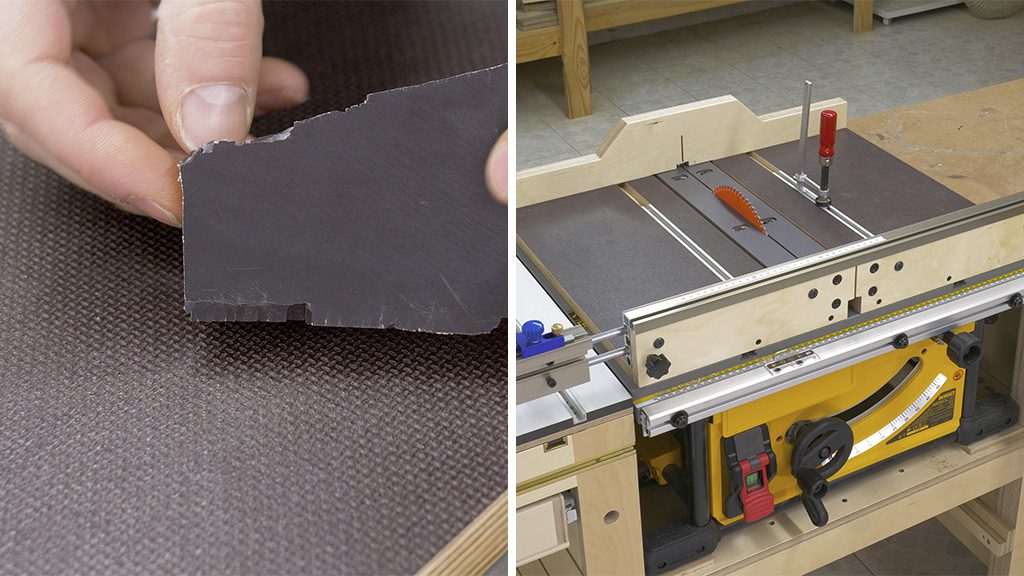

I used birch trailer floor plywood in woodworking projects and tools such as the Mobile Workbench’s table saw sled. The rough, anti-slip face is perfect for supporting pieces on the table so that they won’t move when cutting them.
Also, the bottom face has a smooth melamine layer that’s perfect for sliding the sled on the table saw worktable. This kind of board is also perfect to use as a worktop for homemade tools, even though the melamine layer is not as hard as an HPL sheet.
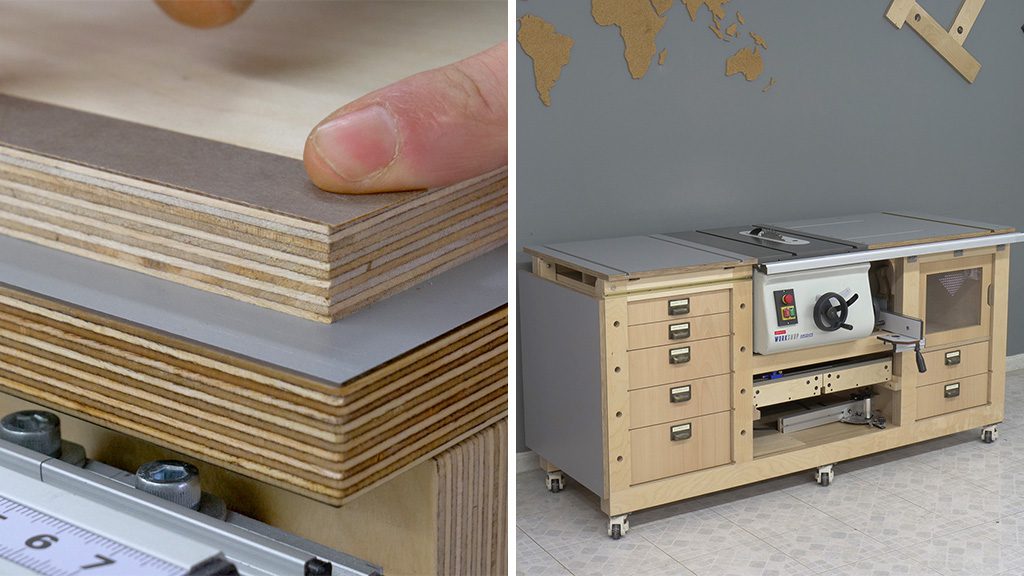

Another kind of hard birch plyboard, in this case with a grey HPL sheet on both sides. The sheet is about 0.5 mm thick and is usually covered with melamine. It’s a rather expensive type of board, but it’s worth investing in it if possible. It’s perfect for making worktops for homemade tools, as in this case.
I used it to make the Mobile Workbench’s worktops. Besides being elegant, the HPL sheet provides the hardness necessary to work on top of the bench and allows the workpieces to slide more smoothly when cutting them.


If you’re looking for stability and lightness, light poplar plywood, or wood of a similar weight and density, is ideal. For example, I used it to make a portable spray booth, which I wanted to be stable yet able to be moved around. Specifically, it’s poplar plywood with an okoume veneer.
I also used it to build the cabinets joining the frames of my multifunction workbench for the same reason. It’s a considerably large workbench which can bear heavy loads, and it feels stable when working on it.
As you can see in the second picture, the cabinets are quite big, so I decided to make them with light plywood to reduce the total weight of the bench. Again, this is poplar plywood with an okoume veneer.
Both the multifunction and the modular workbenches have a lot of drawers to store tools, but at the same time they have wheels to move them around the workshop when necessary.
Again, as before, I was trying to reduce the total weight by making all of these drawers with light plywood; as you can see in the third picture. On this occasion, it’s poplar plywood with a eucalyptus veneer.
For that same reason, I used light plywood to make the wall-mounted bathroom vanity drawers in the fourth picture. These drawers are not going to bear a lot of weight, and since it’s wall mounted, I tried to make it lighter.
Processing Plywood Board:
Plywood is easy to cut in a similar way to solid timber. I use my ultra fine disc mounted on an inverted circular saw and it works perfectly. If it’s hard plywood, it better to use a disc with few teeth, the kind used to cut solid wood. If the tool allows it, it’s advisable to reduce the speed a little. Just like wood, it doesn’t produce too much dust when cut.


It’s a bit harder to machine than solid wood because the layers are alternated. This makes it so that, as you cut into it, you’ll find grain in both directions. When using a router, it’s important to choose a moderate speed, without cutting too deep, to avoid burning the router bit or the board. In the second picture, you can see me doing a straight mill with my 3D Router.
It’s easy to glue to other pieces of plywood or to other materials using wood glue, with good results. In the third picture I had just glued two pieces of birch plywood (9 and 18mm) to achieve a thicker piece.
It’s also easy to put screws in, whether they go into the face or in its edge, as you can see in the fourth picture. When doing this, prior to placing the screw, it’s advisable to drill a pilot hole with a bit 0.5mm less wide than the screw on hard plywood, and 1mm in soft plywood.
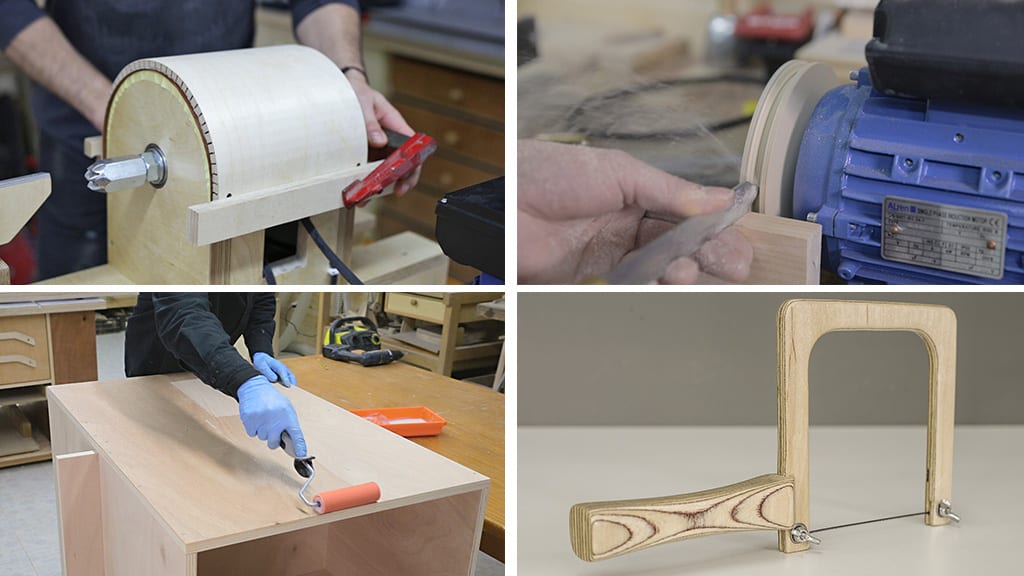

When making the necessary cuts, you may bend the plywood for special jobs, such as the top of my home-made lathe (first picture).
Both hard and soft plywood can be turned, although it’s not as easy a task as with other materials. The alternation of the grain makes this kind of board sturdier, although some well-sharpened chisels can work. In the second picture I’m making a pulley for a band saw.
It’s also very easy to sand and varnish, by hand or with a spray gun, as if it was solid wood. Birch wood is not very porous, so it’s easy to achieve a smooth, even finish. Poplar is a little more porous, so it will need one or two more coats.
You can dye it or lacquer it with an opaque color. The most complicated thing about both boards is sanding the edges, again due to the cross-graining. I usually cut pieces a few tenths of a millimeter bigger so that I can sand the edges down enough to achieve a smooth finish.
Due to the alternation of grain between plies, it’s the ideal board for reliefs and it boasts interesting patterns, just look at the handle of the coping saw in the fourth picture.

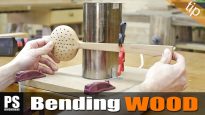

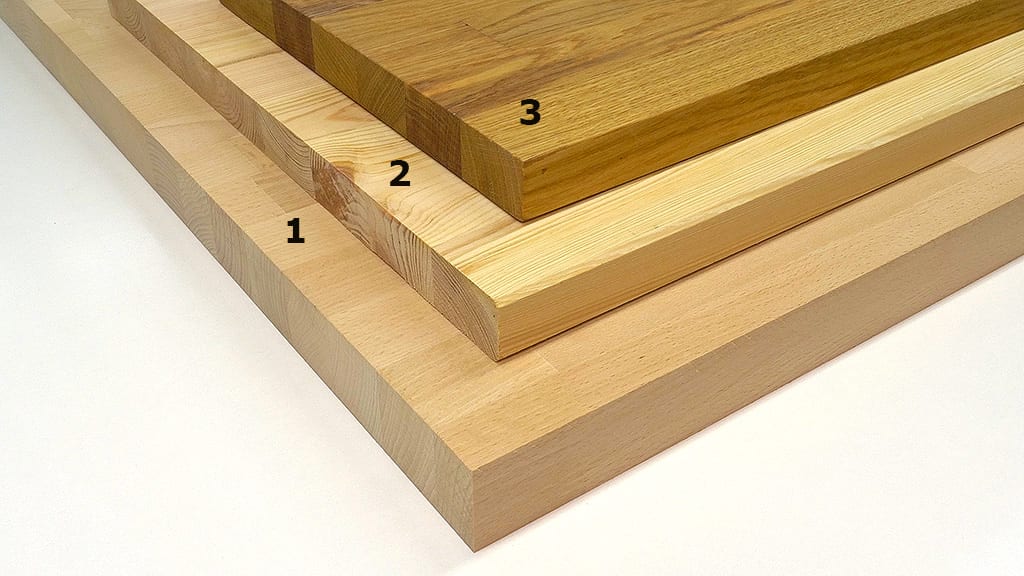
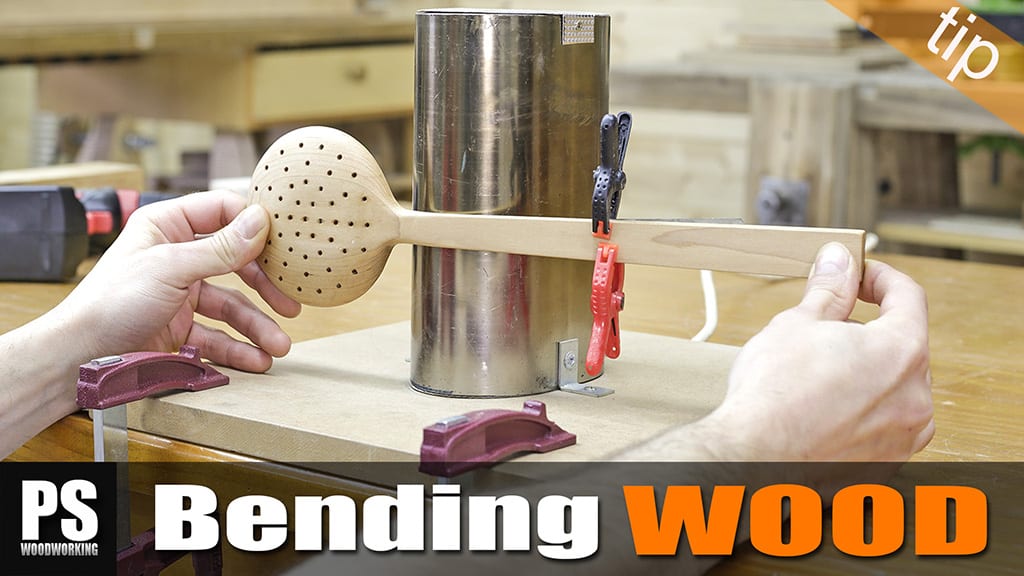



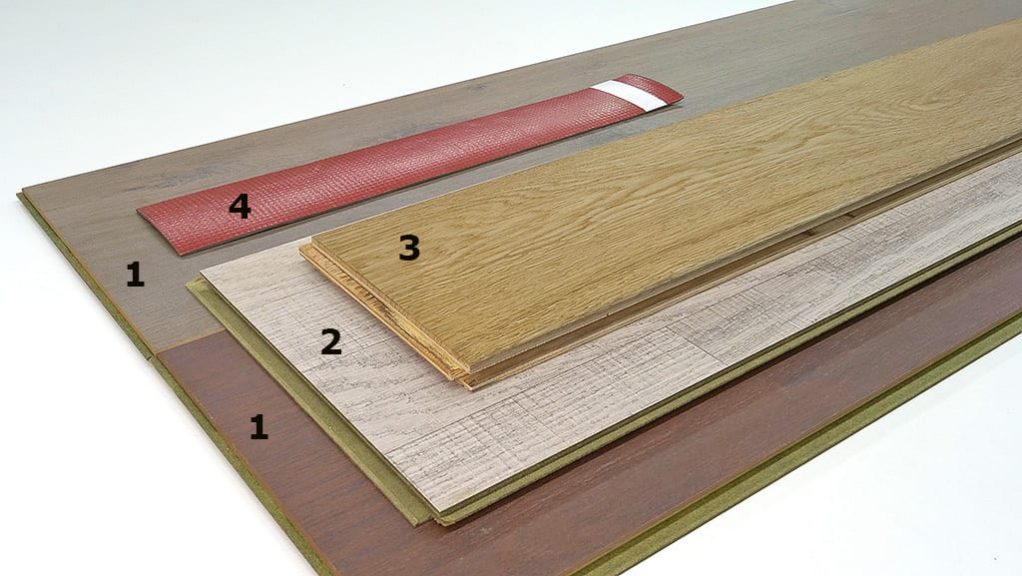
great article, thanks for the info!
thanks Pet!